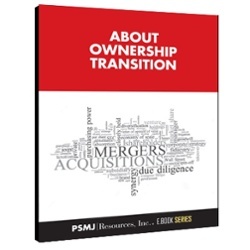 Baby Boomers are looking to retire and pass on ownership of their architecture or engineering firms to the next generation, yet there seems to be are a myriad of road bumps along the way that are making the transition process less than smooth.
Baby Boomers are looking to retire and pass on ownership of their architecture or engineering firms to the next generation, yet there seems to be are a myriad of road bumps along the way that are making the transition process less than smooth.
Consider the following and see if any apply to your firm:
-
Current owners can’t bear to let go. They may be prepared financially, but emotionally they still want to be the one in charge.
-
The next leaders have not been prepared. They haven’t had enough opportunity to develop the necessary leadership or management skills, or they don’t have a good understanding of the business aspects of running the firm.
-
Potential successors cannot afford to buy in. The firm hasn’t been funding the transition over a period of time: Younger employees are not likely to have the independent resources to purchase the firm.
-
The firm waited until it was too late to create a plan. Requirements for a smooth transition have not been considered as part of the firm’s on-going business planning.
No doubt there are some traits of architecture, engineering, planning and interior design firms that differentiate their transfer of ownership from transfers in traditional businesses. Are any of the following standing in the way of your firm's ownership transition planning?
Emotional ties to the profession. Most design firm professionals want immediate ownership, not for economic reasons, but to control their own destiny and build security. They want ownership, but might not understand what ownership means.
Financial secrecy. Because owners tend to keep finances a secret, potential successors don’t understand the business side or the financial status of the firm.
Secondary nature of profit. Profit and profitability take a back seat to doing a good job and job security
The results: a less aggressive spirit.
Ego and entrepreneurial drive. The entrepreneurial drive of the founders is often not found in the second
generation. The results: Entrepreneurs are replaced with groups who don’t like to take risks and who spend their
time vying with each other for position.
To summarize, ownership transition problems generally fall into four categories:
Leadership. The owner has been so busy managing the firm and making all the decisions, that he/she hasn’t spent enough time or thought to develop the people who should be ready to take over as he/she prepares to retire. The most serious problems are leadership problems, not ownership problems.
Financing. The owner approaching retirement still owns a large percentage of the stock. There aren’t enough buyers in the firm with the resources to buy him or her out because the younger people have not been investing in the firm and have other financial commitments.
Valuation. Without careful study and firm data, many owners vastly overestimate the market value of their firm.
Outdated buy/sell agreements. Agreements should be reviewed every two or three years, partly because
circumstances change but especially because tax laws change.
And now consider this! Successful ownership transitions share the following attributes:
-
Future leaders have at least five years’ management experience before they assume leadership.
-
The transition plan has been in operation for several years before the owner’s retirement (ideally, ten to
fifteen years).
-
Everyone understands what is expected of him or her before, during and after the transition.
-
An up-to-date buy/sell agreement is in place.
 A/E/C firm owners who fail to plan properly on ownership transition are leaving the firm exposed to the potential for undesirable outcomes - including significant loss of firm value, brand equity deterioration, and loss of market position. Instead of being another ordinary seminar teaching you how to develop a plan, PSMJ's A/E/C Ownership & Leadership Transition Roundtable takes you through virtually every transition planning obstacle you will encounter (from affordability to leadership development and more) and how to overcome it.
A/E/C firm owners who fail to plan properly on ownership transition are leaving the firm exposed to the potential for undesirable outcomes - including significant loss of firm value, brand equity deterioration, and loss of market position. Instead of being another ordinary seminar teaching you how to develop a plan, PSMJ's A/E/C Ownership & Leadership Transition Roundtable takes you through virtually every transition planning obstacle you will encounter (from affordability to leadership development and more) and how to overcome it.
 PSMJ's complimentary e-book About Ownership Transition goes into real tangible insight and advice on:
PSMJ's complimentary e-book About Ownership Transition goes into real tangible insight and advice on:
-
How to start planning for transition on the day you start your firm
-
An understanding of how transition effects every management decision you make
-
Common pitfalls in the transition process and how to avoid them
-
How to keep your architecture or engineering firm focused on its vision through a transition
You also might be interested in these ownership transition related blog posts:
Changing Expectations of Firm Ownership
How to Get Millennials to Buy In to Firm Ownership
What Potential Firm Owners Need to Know




